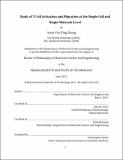Study of T cell activation and migration at the single-cell and single-molecule level
Author(s)
Chang, Irene Yin-Ting
DownloadFull printable version (13.17Mb)
Other Contributors
Massachusetts Institute of Technology. Dept. of Materials Science and Engineering.
Advisor
Jianzhu Chen and Subra Suresh.
Terms of use
Metadata
Show full item recordAbstract
T cells are required by their immunological roles to recirculate in the body and migrate to tissue sites, a journey that exposes them to distorting forces and physical obstacles that hinder their movement. Therefore, they must possess appropriate deformability to accommodate and adapt to these mechanical stimuli to migrate unimpeded. Since T cells alter their physical properties and migration routes upon activation, they may possess dissimilar mechanical properties as a result of this process. This hypothesis was tested using the techniques micropipette aspiration and atomic force microscopy, which allow the investigation of the elastic and viscous responses of single T cells. It was discovered that the activation process reduced T cell stiffness by more than three folds, a finding that agrees with the motility gain observed in activated T cells. The same testing procedure was applied to Wiskott-Aldrich syndrome protein (WASp)-deficient T cells that exhibit abnormal morphology and impaired chemotaxis. The stiffness of the diseased cells in the naive state was 1.5 times less than that of the non-diseased cells, a result that may be due to the disrupted polymerization and cross-linking of the actin cytoskeleton in the absence of WASp, a regulator of actin growth and organization. Furthermore, the viscous response of the diseased cells in the activated state was found to be impaired. Chemokines were found to dramatically reduce the stiffness of naive T cells that were induced to migrate. These findings suggest that WASp plays an important role in maintaining cell mechanical property and facilitating T cell extravasation by tailoring the cells' deformability. At the molecular level, activation of T cells is triggered by the binding of their surface receptors to antigens, a mechanism that is also key in T cell development. In both cases, the bond strength, conventionally measured by the affinity (KD) or the dissociation rate (koff) of the interacting pair, dictates the biological outcome. Since a few weak interactions may nudge a sub-threshold signal over the threshold strength, and observing that the current methods for measuring KD and koff lack the resolution to detect very weak bonds, this work explored the possibility of utilizing dynamic force spectroscopy (DFS) to study very weak binding strengths. Preliminary results confirm this capability.
Description
Thesis (Ph. D.)--Massachusetts Institute of Technology, Dept. of Materials Science and Engineering, 2011. This electronic version was submitted by the student author. The certified thesis is available in the Institute Archives and Special Collections. Cataloged from PDF version of thesis. Includes bibliographical references (p. 167-184).
Date issued
2011Department
Massachusetts Institute of Technology. Department of Materials Science and EngineeringPublisher
Massachusetts Institute of Technology
Keywords
Materials Science and Engineering.